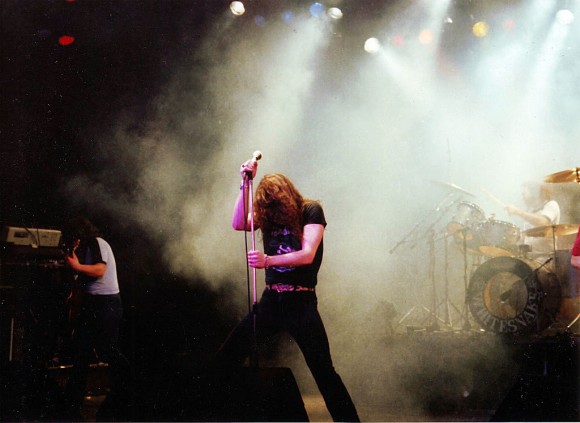aNewDomain — One of the most exciting things for the rock music world in 2015 is Whitesnake’s first new studio recording in four years: The Purple Album. The album is a collection of covers by Whitesnake of Deep Purple songs, which were originally created from 1974 to 1976. Whitesnake founder and leader, David Coverdale, fronted Deep Purple from late 1973 until the band’s demise in the summer of 1976.

Image credit: Whitesnake in 1981. Wikimedia Commons.
The 63-year-old Coverdale says that The Purple Album is intended as “a huge thank you from me to Deep Purple for the opportunity I was given over 40 years ago …”
The tragic loss of Jon made me finally realise that life is too f*****g short to hold animosity, bitterness and resentments. So I decided to reach out to Ritchie to share the sense of grief and loss of Jon with him, and to express my gratitude to him for bringing me on board Deep Purple. During the conversation we did discuss the idea of getting back together in some way, which was Jon’s wish … After several discussions with Ritchie’s manager I felt I didn’t share their vision of the project. I sincerely wished them well and respectfully withdrew … During this time I pulled out the albums and started … re-arranging ideas, adding a new bit here and there. The bonus for me was I rediscovered my love for that time and the work all of us achieved together. Magical times.”
Deep Purple Marks
Deep Purple went through so many personnel changes from 1968 to 1976 (usually of singers and bass players) that rock music historians refer to the various band incarnations as “Marks.” Coverdale fronted the band for the Mark III and Mark IV incarnations.

David Coverdale fronted Deep Purple for the first time on December 8, 1973, at the age of 22. He had impressed the band with a demo tape that he — or his boss at the boutique shirts store where he worked — had sent in when he heard the band needed to replace singer Ian Gillan. Deep Purple also had to replace departed bass player Roger Glover and brought on Glenn Hughes from the bluesy hard rock band Trapeze. Hughes was also a singer, and he often sang harmony and co-lead vocals with Coverdale.
In 1974 the Mark III incarnation of Deep Purple released their first album, Burn. The album went multi-platinum and is regarded as one of the greatest Deep Purple records ever made. The band sold out concerts worldwide and headlined the 1974 California Jam concert.
Video: Deep Purple : The Gypsy (live)
The 1975 follow-up record, Stormbringer, also sold well with the title song regarded as one of Purple’s greatest songs. However, Ritchie Blackmore was becoming disgruntled with the new additions to the band. Hughes and Coverdale listened to a lot of American soul and funk music, which the Renaissance and Baroque-inspired Blackmore loathed. They brought these influences into the music, beginning with Stormbringer, and Hughes in particular began to take a more prominent songwriting role, which cut into Blackmore’s leadership.
After recording Ritchie Blackmore’s Rainbow, intended to be a one-off solo project with members of the band Elf, Blackmore quit Deep Purple, which he had co-founded, in the late summer of 1975 to form a permanent rendition of Rainbow.
Tommy Bolin, Blackmore’s eventual replacement, had built himself a stellar reputation as a guitar player with Zephyr, The James Gang and Billy Cobham’s Spectrum. He could rock hard but also shared Hughes’ and Coverdale’s enthusiasm for American soul music, making him a perfect fit for the Mark IV Deep Purple. Unfortunately, Bolin was a heroin addict.
Drug addictions, affairs with women and prima donna competitions between Coverdale and Hughes led Deep Purple to a break-up in July of 1976, about a year after Blackmore’s departure. Bolin died of an overdose in December of that year. The Mark IV incarnation recorded one studio album, Come Taste the Band.
http://www.youtube.com/watch?v=088aBbcJ8Qg
Video: Deep Purple – Love Child HD 1975 ( Live in Japan)
Whitesnake
After the breakup of Deep Purple, David Coverdale recorded two solo albums. These bluesy albums contained little of the hard rock of Deep Purple.
In 1978, Coverdale founded Whitesnake. The band was named after one of Coverdale’s solo songs with its signature poetically filthy lyrics. Originally, the band was a hard-edged blues outfit with six members, including Jon Lord. The music was heavy enough to recall moments of the Purple’s Burn days.

Image credit: Whitesnake in 1980. Wikimedia Commons.
In 1979, former Deep Purple drummer Ian Paice joined Whitesnake. However, due to musical differences with Coverdale, he left the band in 1982. Jon Lord left in 1984 to join the reconstituted Deep Purple Mark II with Blackmore, Gillan, Glover and Paice.
Just before he left, Lord helped Whitesnake make their commercial breakthrough in the United States. Still bluesy, but now with a truly metallic edge, the band’s Slide It In record went gold in the U.S. and had five songs that received much radio airplay. From this time the band would always be a revolving door of personnel, Coverdale being the only original member.
In 1987, the album Whitesnake saw the band playing full-blown heavy metal and reached double-platinum status in the U.S. The success of this record also lifted Slide It In into double-platinum sales territory. The late 1980s were the time of greatest commercial success for Whitesnake in the U.S.
http://www.youtube.com/watch?v=Xk9wWj8Wh30
Video: Whitesnake – Stormbringer (Official Video) (The Purple Album / New Studio Album / 2015)
Purple Patch
At the time of this writing the only song available for listening from The Purple Album is “Stormbringer.” It’s an energized, metallic rendition done by the current Whitesnake ensemble, which features two guitar players but no keyboard player. A few listens to the single raise a few questions in my mind:
How has Coverdale treated the keyboard parts throughout the album, especially on the cover of the organ-dominated “Might Just Take Your Life”? I’m skeptical as to whether guitar synths can take the place of Jon Lord. It will be interesting to hear how the second guitar player is used to fill in this gap, and I hope it works.
Coverdale is now in his 60s and has always been a heavy smoker. His voice is nothing like what it was during his Deep Purple days. His voice is now a rasp, albeit a powerful one, and it sounds like it has received help from the studio mix. How will he hold up singing these songs in concert?
What has been done with Hughes’ vocal parts? Performing live, who will sing them, or at least sing harmony with Coverdale? I hope Whitesnake doesn’t resort to those asinine pre-recorded harmony vocals that they’ve used in live settings before.
These concerns aside, I can’t wait to buy this album — perhaps on iTunes, perhaps the CD, perhaps even the double-vinyl — when it’s released on May 19th.
For aNewDomain, I’m Brant David.
Featured image: Courtesy of Whitesnake













